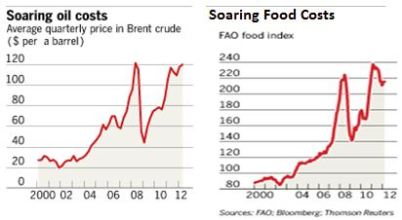 Although scientists are in dissension if global warming is caused by the effect of humans and their footprint on this earth, the matter has an increased concern with consumers and governments. CO2 footprint seems to be the biggest concern. In this article I try to overlook a few reports that have been published, comparing the carbon footprint of different meat types.
Although scientists are in dissension if global warming is caused by the effect of humans and their footprint on this earth, the matter has an increased concern with consumers and governments. CO2 footprint seems to be the biggest concern. In this article I try to overlook a few reports that have been published, comparing the carbon footprint of different meat types.
1 kg of meat as harmful as driving 1.600 km?
Headlines in newspapers stated “one kilogram of meat as harmful to the climate as diving up to 1.600 kilometers in a car.” This statement has been derived from an Austrian and Dutch study (2011), which concluded that the production of one kg of Brazilian beef produces 335 kg of carbon dioxide (CO2). The carbon footprint of Dutch beef is much lower with 22 kg carbon dioxide per kg of meat. Good news for poultry producers, as it produces 6.2 kg of CO2 per kg of meat. The results of this research are subject to discussion as it also comprises the area used for production, assuming that natural vegetation doesn’t regrow on these grounds and do not absorb CO2.
Again good news for chicken
The American Environmental Working Group (EWG) produced the Meat Eaters Guide in 2011 with the comparison of several types of meat and their carbon footprint post farmgate and production emissions. The EWG claims on their website to be conservative, if compared to other research. In this comparison lamb meat has the biggest impact, producing 39.2 kg of CO2 per kg of consumed food. Chicken meat has the lowest impact of 6.9 kg CO2 per kg of meat.
Organic production highest footprint
The European website agri-footprint.com (Blonk consultancy) also compares the CO2 footprint of several production types. Several types of production can be overlooked on global warming potential (CO2 output), energy use and land occupation. Poultry production again scores well on all 3 elements. In this calculation the whole production change is overlooked from parent stock until slaughter house. In this calculation 1 kg of chicken meat produces 3.4 kg of CO2.
Even more interesting is the comparison of Blonk for a Dutch bank (see graph below), comparing traditional eggs (eieren) and meat (kippenvlees) with free range and organic (biologisch) products. It seemed that the CO2 footprint of organic chicken meat is much higher (+58%) than traditional meat.
Lowering CO2 emissions on farm level
Especially in broiler production a lot of energy is used in heating the house when day old chicks arrive. Many farms use fossil fuel heaters to achieve the necessary temperatures, but by common climate systems a lot of warm air is ventilated out of the house. With a so called heat exchanger, farmers can recover the heat and warm their fresh incoming air. In this way, there is less need for the heaters to burn. This reduces the CO2 footprint on farm level and improves the climate in the broiler house. An example of a heat exchanger for poultry houses is the Clima+ unit of Agro Supply.
The reason why CO2 footprint of Dutch broiler production is lower then elsewhere in the world (see above research), is perhaps in the fact that farms need to comply to certain regulations for ammonia output. In this way the use of heat exchangers is encouraged and thus lowering the CO2 footprint of broiler production.
My conclusions
All research show that chicken meat has the lowest impact on global warming of all meat types. Due to efficiency and techniques used to reduce the energy needed for production, the Dutch broiler sector knows a very low CO2 output. Organic production seems to have a much higher carbon footprint and thus it can be questioned how sustainable this production type actually is with respect to global warming. With a heat exchanger for poultry houses poultry producers can reduce their footprint.




